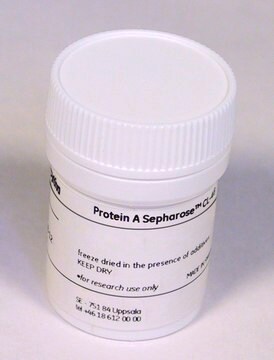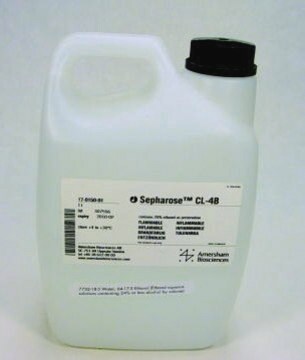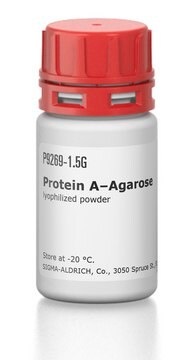GE17-0780-01
Protein A-Sepharose™ CL-4B
Cytiva 17-0780-01, pack of 1.5 g
Synonym(s):
Protein A Sepharose, Sepharose CL-4B
About This Item
Recommended Products
ligand
native protein A
packaging
pack of 1.5 g
manufacturer/tradename
Cytiva 17-0780-01
storage condition
(20% Ehtanol)
matrix
4% cross-linked agarose
particle size
45-165 μm
average diameter
90 μm
cleaning
2-10
working range
3-9
capacity
~40 mg binding capacity (histidine-tagged protein/ml medium when changed with Ni2+)(Protein- and metal-ion dependent.)
storage temp.
2-8°C
Related Categories
General description
Protein A binds to the Fc region of immunoglobulins through interactions with the heavy chain. The binding of protein A has been well documented for IgG from a variety of mammalian species and for some IgM and IgA as well. Protein A Sepharose™ CL-4B has been used as a powerful tool to isolate and purify classes, subclasses and fragments of immunoglobulins from biological fluids and from cell culture media. Since only the Fc region is involved in binding, the Fab region is available for binding antigen.
Features and Benefits
- Well documented for immunoglobulin purification and fractionation
- Strong binding to Fc region of IgG
- High capacity - 20 mg human IgG/mL.
- Suited for immunoprecipitation procedures
Storage and Stability
Analysis Note
Legal Information
Storage Class
13 - Non Combustible Solids
Choose from one of the most recent versions:
Certificates of Analysis (COA)
It looks like we've run into a problem, but you can still download Certificates of Analysis from our Documents section.
If you need assistance, please contact Customer Support.
Already Own This Product?
Find documentation for the products that you have recently purchased in the Document Library.
Customers Also Viewed
Our team of scientists has experience in all areas of research including Life Science, Material Science, Chemical Synthesis, Chromatography, Analytical and many others.
Contact Technical Service









